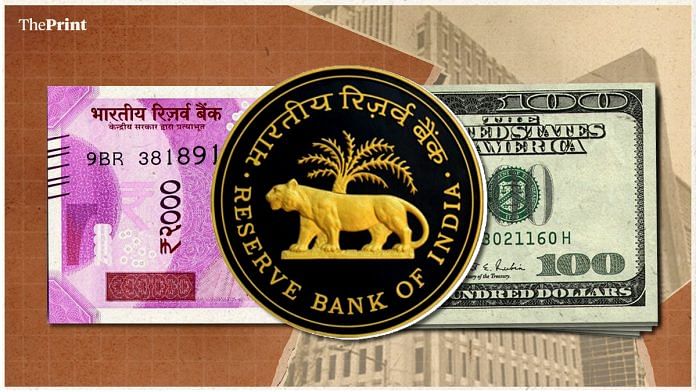The Reserve Bank of India (RBI)’s foreign exchange reserves have been increasing sharply, suggests new data. Since April 2020, the RBI’s dollar reserves have grown by over $100 billion to now stand at $608 billion, making India the fifth-largest reserve holding country in the world.
The central bank has justified its forex intervention by talking about reserve adequacy. It has been argued that the RBI does not hold more than 15 months of import cover while some countries hold more. Switzerland, Japan, Russia and China hold more reserves than India and their import covers are 39 months, 22 months, 20 months and 16 months, respectively.
However, over the last two decades, the RBI’s forex intervention has been motivated by concerns about currency movements.
Also read: How the pandemic can help make digital currencies truly global
Eye on currency, but conflict with inflation targeting
The recent increase in reserves has been prompted by an attempt to prevent large rupee appreciation. In June 2020 the rupee-dollar exchange rate stood at 75.6 while now it is around 72.8, a small appreciation. Intervention helped prevent a larger appreciation.
Not only does such currency manipulation invite the ire of other nations, it is costly as it is inflationary.
Moreover, if there is a serious speculative attack on the currency, reserves are not used to prevent depreciation. In the past, the RBI has tightened monetary policy and used capital controls in order to prevent the rupee from falling, instead of selling off its billions.
The central bank does not want the rupee to appreciate as that makes exports uncompetitive. Hence it intervenes in the forex market to buy dollars.
Such a course of action, as adopted by China for many decades, is seen as a “beggar thy neighbour” policy because it makes other countries worse off. This is not looked upon kindly.
In April this year, the US decided to retain India on its watchlist of currency manipulators. India had been on this list since December 2020.
The US puts countries on the list of manipulators if they meet two of the three criteria over a 12-month period: (a) bilateral trade surplus with the US of over $20 billion; (b) current account surplus of at least 2 per cent of GDP; (c) net purchase of foreign currency amounting to at least 2 per cent of the country’s GDP.
According to the US Treasury Department’s report released in April, India was kept on this list because the RBI’s net forex intervention amounted to 5 per cent of GDP in the previous 12-month period, and because India’s bilateral trade surplus with the US had exceeded $20 billion.
Among the many costs of RBI’s currency intervention, an important one is that adding to its forex assets increases the money supply in the domestic financial system.
An expansion in the money supply exerts inflationary pressures which might be damaging for the economy.
Also read: Inflation will moderate — 5 reasons why you should not worry too much about high prices
Are forex reserves held for preventing currency weakness?
One of the reasons a high level of reserves is considered useful is because it gives the central bank enough ammunition to fight against future currency depreciation.
If the currency starts depreciating against the dollar, then the central bank can sell its dollar reserves and buy the local currency in order to stop the depreciation. But this rarely happens in the case of a speculative attack on the currency.
With the US economy overheating due to the massive fiscal stimulus implemented by the US government, inflation in the US is on the rise. This could prompt the US Federal Reserve to start raising the policy interest rate.
If that happens, the situation for emerging economies like India will be similar to the Taper Tantrum episode of May 2013, when the US Fed had signalled a tapering of its Quantitative Easing policy. This had led to capital outflows from India as well as other emerging economies causing their currencies to depreciate.
Defending the exchange rate by selling reserves invites speculators. When people see that the RBI is selling reserves, they expect that when reserves will fall to a very low level, the central bank will be forced to stop intervening and the currency will weaken. Foreign as well as domestic investors start taking money out before this event materialises. Their speculative attack on the currency ends up hastening the currency depreciation.
During the taper tantrum, to prevent depreciation, the RBI tightened monetary policy, squeezed liquidity from the system and imposed capital controls. It used a very small part of its reserves.
In May 2013, RBI’s forex reserves were at around $288 billion. Between May and September, 2013, it sold roughly $22 billion. Even so, the rupee witnessed a sharp depreciation from 56.5 in May 2013 to 62.8 in September 2013.
The central bank’s build up of reserves lets businesses believe that the rupee will not weaken sharply. They think that RBI’s stock of reserves will be used against big currency fluctuations. This in turn prevents these firms from hedging the dollar exposures on their balance sheets.
It creates a never-ending vicious cycle wherein the more RBI hoards, the more confident these firms become to take unhedged exposure, thus avoiding the costs of hedging and then the greater the justification for the RBI to hoard reserves.
Ila Patnaik is an economist and a professor at National Institute of Public Finance and Policy.
Rajeswari Sengupta is an Assistant Professor of Economics at the Indira Gandhi Institute of Development Research in Mumbai, India.
Views are personal.
Also read: Indian family budgets are stretched, they’re borrowing more. Faster vaccination can fix this



